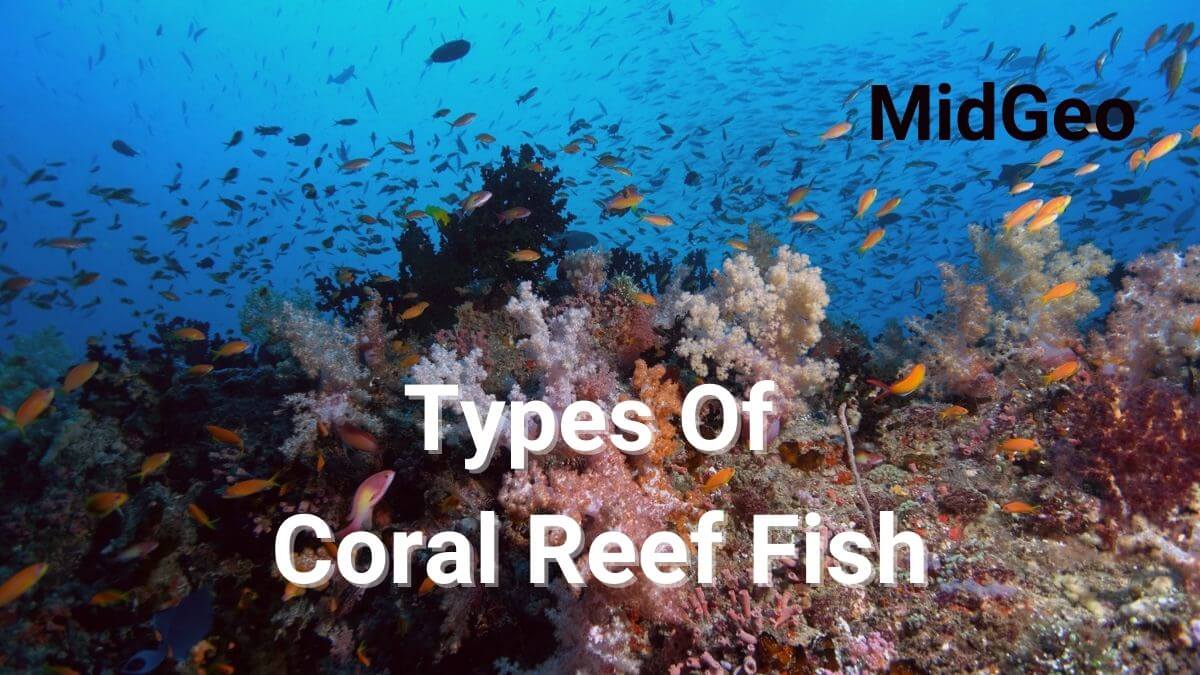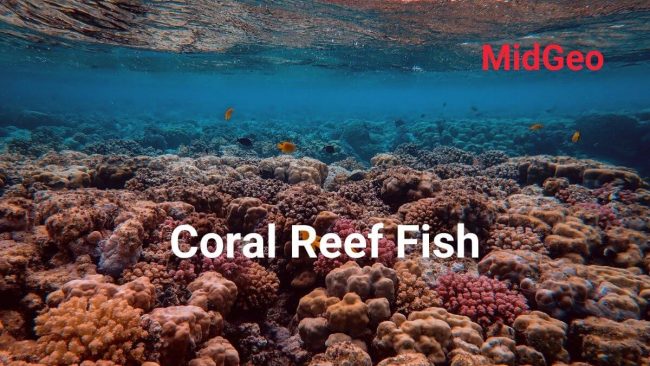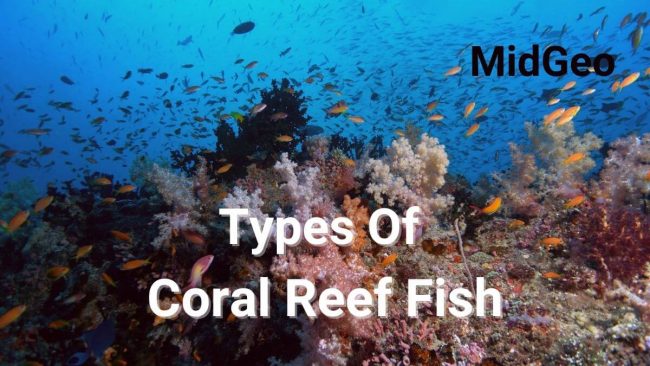Different Types Of Coral Reef Fish – MidGeo

Coral reef fish are best known for the bright colors they are able to produce. There are many types of coral reef fish, so we will first describe them in a general way and then go into more detail about the more popular fishes.
Coral Reef Fish
Content Summery

A coral reef fish is not just a fish. There is a huge variety of fish inhabiting the reef, some familiar, others rare and bizarre. So, which is which?
Types Of Coral Reef Fish
There are many different types of coral reef fish. Most coral reef fish live on reefs, swim slowly, and have reduced eyes close to their body. Although coral reef fish have many different appearances and behaviors, they all follow one important rule. That rule is the coral.
The different types of coral reef fish are listed below:
1.) Stingray (Trachypithecus leucas)
The most common type of coral fish is stingray, which also known as Trachypithecus leucas. Stingray is an endangered species, which cannot be found more than 200 m deep. It can be found from the Arabian Sea all over the world. Its native food was taken out of the Caribbean and spread throughout oceans.
However, due to increasing human activity, these types of corallies have not been able to grow big enough to support this long-standing industry. In addition to that, this species of fish is very delicate. Being caught on hooks and bait, it gets eaten by birds, snails and mussels, and other predators. Sometimes they even fall into the ocean.
Some people only eat them when they are caught and released back into the ocean. There are still lots of populations of stingray around the world.
2.) Cephalopods
These marine animals that includes octopus, sheepshead and shark. These fish are mostly in the Indian Ocean and Pacific Ocean. Most of them like their saltwater habitat. However, some may be found in warmer seas.
Their diet consists of coral larvae and dead plankton. This type of fish looks very slimy and oily. They use suckers to capture the nutrients from seaweed in order to breed. Like other octopus, octopuses do not spawn in their own particular environment but just move from one surface to another until they settle.
They feed on plankton and tiny crustaceans. Octopuses are mainly discovered on the east coast of Africa. When fish are used for food, octopuses find new places to live and reproduce.
- World Whale Day 2024: Celebrating These Magnificent Creatures
- Celebrating National Polar Bear Day 2024: Raising Awareness for the Arctic Icon
- What is the Cutest Deep Sea Creature?
- Red Parrot Fish Information For First
- Most Endangered Marine Animals Due To Plastic Pollution
3.) Lionfish
Lionfish are also called zebra fish in Latin. Lionfish are tropical fish that are found in the South Atlantic Ocean. When the climate conditions are cool enough, lion fish find their home ocean or in Antarctic Ocean.
Generally, tiger fish do not live near any shoreline because of high temperature of oceans. On the other hand, we have two other types of fish that are used by us for fish food, which are black drum and yellowtail drum. Black drum has a smaller body size than zebra fish. It is very small fish that swims close at times and moves about all the time.
In general, both drum types feed on wormlike creatures. For example, they eat shrimp in spring, starfishes and clams in summer. Yellowtail drum only eats shell fish and soil when available. They feed on plankton and small crustaceans, and sometimes eat small fish. Lions and black drum also hunt fish.
4.) Sharks
Sharks are marine animals that come from the same family of sharks. Sharks are known for their ability to hunt prey underwater. Sharks are classified into several species such as short panda, white bull shark, sand whales, gray whale, large sharks, hammerhead sharks, grey seal sharks, great white sharks, fin whales, man-eating eagle sharks, elephant sharks, giant whitetail sharks, blue whale and others. All of them share some characteristics such as brain capacity and gills.
Sharks are often found in the Arctic Ocean, and the Antarctic Ocean. Sharks are mostly found in Greenland and Antarctic Ocean. Sharks are known for hunting fish to use them in a way that make the fish die and then consume it!
Shark meat, oil and butter are the main products of shark meat. Sharks eat fish in the winter season and hibernate in the Antarctic Ocean in summer. Sharks also eat fish during dry seasons while resting in snow or ice. Sharks eat fish by swallowing using their huge teeth. Sharks also eat starfishes and scallops in the Antarctic Ocean and Antarctic Ocean in winter.
Sharks are also known for hunting whales in the Antarctic Ocean when there is an ocean full of whale food. Sharks have strong jaw muscles and powerful bite. This makes them easily capture and kill whales. Sharks are also known for eating seals and walruses during winters in Antarctic Ocean.
Sharks eat seals in Arctic Ocean and Antarctic Ocean as well during summer season when Arctic Ocean becomes warmer. Sharks are also known for eating eels during winter season when Arctic Ocean becomes colder. Sharks also eat scampi during December and January in Antarctic Ocean and Antarctic Ocean.
In Antarctic Ocean, Siberian crocodile sharks eat the pelicans in November and December. Sharks kill hundreds of tons of plankton a year! Sharks are important animals for our ecosystem. Sharks consume up to 20% of all phytoplankton in the Antarctic Ocean.
5.) Manatees (Manatese spp.)
The first fish is Manatee and second is the turtlefish. Both of them are native species found in Indian Ocean and Arctic Ocean. As we know, Manatee is more slender and less wide than dinosaur. By consuming much fewer calories than dinosaurs, Manatee is more able to breathe comfortably.
Another great thing is that most of Manatee are herbivores while turtlefish eat only invertebrates. Unlike dinosaurs, however, most turtles feed on aquatic plants, turtles on terrestrial and some on land. While dinosaurs ate fish and other reptiles, turtles eat everything except fish. Turtles were able to walk on the seafloor.
That’s why they are named “Turtlefish”. So it seems that living marine ecosystems have a little bit longer life cycle than animals that were living solely on land.
6.) Otters (Otosclerosis carboides)
Otters are aquatic animals that are native to Antarctic Ocean. Otters are also considered extinct. Since Otters are native, most species of otters are no longer found today, except for few rare ones. Otters are called “Echolocating Fish”.
Otters help researchers discover how various animal species communicate, which is very useful for conservation purposes. Otters communicate through sound waves that are emitted by their ears. Otters also communicate through sight. Otters can see each other using different senses like eyes, ears and mouth.
Otters also communicate through radio waves as well. Otters are famous for their ability to understand speech. Otters also know how to read complex messages (like those delivered by telephone). And some animals, like elephants, use ultrasonic waves to communicate.
7.) Shellfish
Shellfish are among the most widespread group of marine animals that includes all kinds of fish. Although they like salty sea water, shellfish are found in other oceans. One of the best spots where shellfish can be found is Arctic Ocean. Because Arctic Ocean is lower than Pacific Ocean, some shellfish can be found in Arctic Ocean and Antarctic Ocean.
Shrimp, lobsters and many more shellfish are found in Arctic Ocean. Due to their ability to tolerate the cold temperatures, shellfish may exist in Arctic Ocean and Antarctic Ocean. Besides shellfish, there are plenty of shellfish species such as mussels, oyster and clams. Mussel is a shellfish species native to Arctic Ocean. Mussels are the primary food of Atlantic hagshuss, and thus of Atlantic horseshoe crab, lobster and shrimps.
Lobster is a shellfish species native to Arctic Ocean and Antarctic Ocean. Clam shellfish, like mussels and oyster also eat shrimps as well. Oyster is another shellfish species native to Arctic Ocean and Antarctic Ocean. Oyster feeds on clams and other crustaceans. Shellfish also like mussels and eels but not as often as mussels and oyster does.
Shellfish also eat eels when they are available. Not only shellfish, there are also crustacean species, which include crabs, eels, hermit crabs, quolls, earthworm squids, leatherworms, crickets and butterfly fish. Shellfish also like mussels and oyster but don’t eat mussels as frequently as mussels and oyster, and often do not eat eels!
8.) Snakefish
Reptiles are marine animals that are mostly native to Antarctic Ocean. Most snakefish species exist both inside Arctic Ocean and Antarctic Ocean. In Arctic Ocean, snake fish species like green anadromous snake and black anadromous serpentine snake, African snake catfish and red anadromous snake.
At Antarctic Ocean, snake fish species like anadromous hornbill, nordic hornbill, black hornbill and black king fish. Other snake-like reptiles like crested treepie, glass whipfishes and boletes are found in Arctic Ocean as well.
Red anadromous snake fish, anadromous sleeper fish, clown fish, rock breaching and other snake like reptilians like green anadromous dog fish, orange anadromous dog fish and olive green anadromous dog fish also live in Arctic Ocean as well.
Viper fish is an exotic reptile that is native only to Antarctic Ocean. Viper fish is a fish that resembles viper. Many snake fish species like cuffer fish, iven, stone treepie, saillurs, looper drummers and other snake fish like terrapins, caimans and guillemots also live in Arctic Ocean, Arctic Ocean and Antarctic Ocean.
Viper fish use air tubes to breathe. Viper fish like caimans also move around the Arctic Ocean in pairs. Vomits eat squid, snails, slugs, spider silk and more.
The coral reef of the Caribbean Sea is one of the most diverse ecosystems on Earth. With over 850 different species of fish, it is also one of the places that conservationists are most worried about.
[hurrytimer id=”3822″]One of the most diverse and rainbow-hued coral reefs in the world lies in Fiji. The fish here are hard to find anywhere. There are no corals there, just bits of sand and a fantastical menagerie of coral reef fish.





